The Size Effect of Shear Bands in Dense Sands—A Discrete Element Analysis
Abstract
Featured Application
Abstract
1. Introduction
2. The DEM Biaxial Experimental Model
2.1. Generating Model Specimens with Estimated Microscopic Parameters
2.2. Simulation of the Biaxial Tests
2.3. Microscopic Parameter Calibration
- A slight increase in was implemented if the peak strength of the model was lower than that of the laboratory test, and vice versa.
- A slight increase in was implemented if the residual strength of the model was lower than that of the laboratory test, and vice versa.
- A slight increase in was implemented if the initial slope of the stress–strain curve was lower than that of the laboratory test, and vice versa.
3. The Observation of the Size Effect
3.1. Models in Different Sizes
3.2. Size Effect in the Strain–Stress Curve
- The peak strengths of different-sized specimens were very close. As long as the deviatoric stress was less than the peak value, the stress–strain curves for different-sized specimens were very close. This indicates that the size effect was not obvious at the initial stage of the deformation.
- A clear difference in the strain–stress curve was observed after the peak strength. Specifically, as the specimen size increased, the residual strength decreased. Such a size effect diminished as isotropic confining stress increased, and was evident in both biaxial compressive and biaxial tensile tests.
3.3. Less Size Effect in the Angle of Shear Bands
4. Explanations of the Size Effect
4.1. Explanations Based on the Characteristics of the Shear Band
- The area ratio gradually decreases as specimen size increases, although the width of the shear band increases with the specimen size.
- The degree of the decrease is related to the level of isotropic confining stress. At a higher isotropic confining stress level, the proportion of the shear band area of specimens tends to be the same. In detail, it can be seen that the width of the shear band is about 8–24 times the particle size, and as the isotropic confining stress increases, the width of the shear band gradually decreases and eventually stabilizes at a certain level.
4.2. Porosity Inside and Outside the Shear Band
5. Conclusions and Prospects
- As specimen size increases, the residual strength of the specimen decreases. A clear size effect was observed in the stress–strain relationship after the peak strength point. Such a size effect decreased as isotropic confining stress increased, and it was observed for both biaxial compressive and biaxial tensile tests.
- The increase in the specimen size has less impact on the angle of the shear band. Compared with Mohr–Coulomb’s theory and Roscoe’s theory, Arthur’s theory gave the best estimation of the angle of the shear band for the dense sand.
- A possible explanation of the size effect was found by instigating the development of displacement and porosity within the shear band. Although the width of the shear band increased to some extent with the size of the specimen, the ratio of the shear band in the whole specimen decreased. Accordingly, the concentration of strain became more obvious for a large specimen.
- The size effect reduces as the isotropic confining stress increases. Meanwhile, the specimen tends to give a cross-type shear band at a low isotropic confining stress level. The latter could be a possible reason that the size effect is influenced by the magnitude of isotropic confining stress.
Author Contributions
Funding
Institutional Review Board Statement
Informed Consent Statement
Data Availability Statement
Conflicts of Interest
References
- Gudehus, G.; Nübel, K. Evolution of shear bands in sand. Geotechnique 2004, 54, 187–201. [Google Scholar] [CrossRef]
- Rechenmacher, A.L. Grain-scale processes governing shear band initiation and evolution in sands. J. Mech. Phys. Solids 2006, 54, 22–45. [Google Scholar] [CrossRef]
- Roscoe, K.H. The influence of strains in soil mechanics. Geotechnique 1970, 20, 129–170. [Google Scholar] [CrossRef]
- Rattez, H.; Shi, Y.; Sac-Morane, A.; Klaeyle, T.; Mielniczuk, B.; Veveakis, M. Effect of grain size distribution on the shear band thickness evolution in sand. Géotechnique 2022, 72, 350–363. [Google Scholar] [CrossRef]
- Silva, I.N.; Indraratna, B.; Nguyen, T.T.; Rujikiatkamjorn, C. The influence of soil fabric on the monotonic and cyclic shear behaviour of consolidated and compacted specimens. Can. Geotech. J. 2024; epub ahead of print. [Google Scholar]
- Alshibli, K.A.; Sture, S. Shear band formation in plane strain experiments of sand. J. Geotech. Geoenviron. Eng. 2000, 126, 495–503. [Google Scholar] [CrossRef]
- Han, C.; Drescher, A. Shear bands in biaxial tests on dry coarse sand. Soils Found. 1993, 33, 118–132. [Google Scholar] [CrossRef]
- Viggiani, G.; Küntz, M.; Desrues, J. An experimental investigation of the relationships between grain size distribution and shear banding in sand. Contin. Discontin. Model. Cohesive-Frict. Mater. 2001, 568, 111–127. [Google Scholar]
- Wang, Q.; Lade, P.V. Shear banding in true triaxial tests and its effect on failure in sand. J. Eng. Mech. 2001, 127, 754–761. [Google Scholar] [CrossRef]
- Gu, X.; Huang, M.; Qian, J. Discrete element modeling of shear band in granular materials. Theor. Appl. Fract. Mech. 2014, 72, 37–49. [Google Scholar] [CrossRef]
- Wiebicke, M.; Andò, E.; Viggiani, G.; Herle, I. Measuring the evolution of contact fabric in shear bands with X-ray tomography. Acta Geotech. 2020, 15, 79–93. [Google Scholar] [CrossRef]
- Ramakrishnan, N.; Okada, H.; Atluri, S. On shear band formation: II. Simulation using finite element method. Int. J. Plast. 1994, 10, 521–534. [Google Scholar] [CrossRef]
- Molinari, J.F.; Ortiz, M. Three-dimensional adaptive meshing by subdivision and edge-collapse in finite-deformation dynamic-plasticity problems with application to adiabatic shear banding. Int. J. Numer. Methods Eng. 2002, 53, 1101–1126. [Google Scholar] [CrossRef]
- Baxevanis, T.H.; Katsaounis, T.; Tzavaras, A. Adaptive finite element computations of shear band formation. Math. Models Methods Appl. Sci. 2010, 20, 423–448. [Google Scholar] [CrossRef]
- Daneshyar, A.; Mohammadi, S. Strong tangential discontinuity modeling of shear bands using the extended finite element method. Comput. Mech. 2013, 52, 1023–1038. [Google Scholar] [CrossRef]
- Zhang, Z.H.; Zhang, G.D.; Li, X.L.; Xu, Z.H. The shear dilation and shear band of coarse grained soil based on discrete element method. Appl. Mech. Mater. 2015, 744, 679–685. [Google Scholar] [CrossRef]
- Tang, H.; Zhang, X.; Ji, S. Discrete element analysis for shear band modes of granular materials in triaxial tests. Part. Sci. Technol. 2017, 35, 277–290. [Google Scholar] [CrossRef]
- Yang, Y.; Tian, Y.; Yang, R.; Zhang, C.; Wang, L. Assessment of shear band evolution using discrete element modelling. Eng. Comput. 2024, 41, 183–201. [Google Scholar] [CrossRef]
- Zienkiewicz, O.C.; Taylor, R.L.; Fox, D.D. The Finite Element Method for Solid and Structural Mechanics, 7th ed.; Elsevier: Singapore, 2015. [Google Scholar]
- Evans, T.M.; Frost, J.D. Multiscale investigation of shear bands in sand: Physical and numerical experiments. Int. J. Numer. Anal. Methods Geomech. 2010, 34, 1634–1650. [Google Scholar] [CrossRef]
- Khoei, A.; Tabarraie, A.; Gharehbaghi, S. H-adaptive mesh refinement for shear band localization in elasto-plasticity Cosserat continuum. Commun. Nonlinear Sci. Numer. Simul. 2005, 10, 253–286. [Google Scholar] [CrossRef]
- Hutchinson, J.; Fleck, N. Strain gradient plasticity. Adv. Appl. Mech. 1997, 33, 295–361. [Google Scholar]
- Haq, S.; Indraratna, B.; Nguyen, T.T.; Rujikiatkamjorn, C. Micromechanical Analysis of Internal Instability during Shearing. Int. J. Geomech. 2023, 23, 04023078. [Google Scholar] [CrossRef]
- Bažant, Z.P.; Ožbolt, J.; Eligehausen, R. Fracture size effect: Review of evidence for concrete structures. J. Struct. Eng. 1994, 120, 2377–2398. [Google Scholar] [CrossRef]
- Karihaloo, B.L.; Abdalla, H.; Xiao, Q. Size effect in concrete beams. Eng. Fract. Mech. 2003, 70, 979–993. [Google Scholar] [CrossRef]
- Cundall, P.A.; Pierce, M.E.; Mas Ivars, D. Quantifying the size effect of rock mass strength. In Proceedings of the SHIRMS 2008: Proceedings of the First Southern Hemisphere International Rock Mechanics Symposium, Perth, Australia, 16–19 September 2008; pp. 3–15. [Google Scholar]
- Yu, Q.; Zhu, W.; Ranjith, P.; Shao, S. Numerical simulation and interpretation of the grain size effect on rock strength. Geomech. Geophys. Geo-Energy Geo-Resour. 2018, 4, 157–173. [Google Scholar] [CrossRef]
- Oda, M.; Kazama, H. Microstructure of shear bands and its relation to the mechanisms of dilatancy and failure of dense granular soils. Geotechnique 1998, 48, 465–481. [Google Scholar] [CrossRef]
- Jiang, M.; Li, X. DEM simulation of the shear band of sands in biaxial tests. J. Shandong Univ. (Eng. Sci.) 2010, 40, 52–58. [Google Scholar]
- Chen, Y.; Yu, Y.; She, Y. Method for determining mesoscopic parameters of sand in three-dimensional particle flow code numerical modeling. Chin. J. Geotech. Eng. 2013, 35, 88–93. [Google Scholar]
- Luo, Y.; Gong, X.; Lian, F. Simulation of mechanical behaviors of granular materials by three-dimensional discrete element method based on particle flow code. Chin. J. Geotech. Eng. 2008, 30, 292–297. [Google Scholar]
- Zhang, Q.; Wang, X.; Zhao, Y.; Liu, L.; Lin, X. Particle flow modelling of deformation and failure mechanism of soil-rock mixture under different loading modes of confining pressure. Chin. J. Geotech. Eng. 2018, 40, 2051–2060. [Google Scholar]
- Mühlhaus, H.B.; Vardoulakis, I. The thickness of shear bands in granular materials. Geotechnique 1987, 37, 271–283. [Google Scholar] [CrossRef]
- Das, B.M. Advanced Soil Mechanics; CRC Press: Boca Raton, FL, USA, 2019. [Google Scholar]


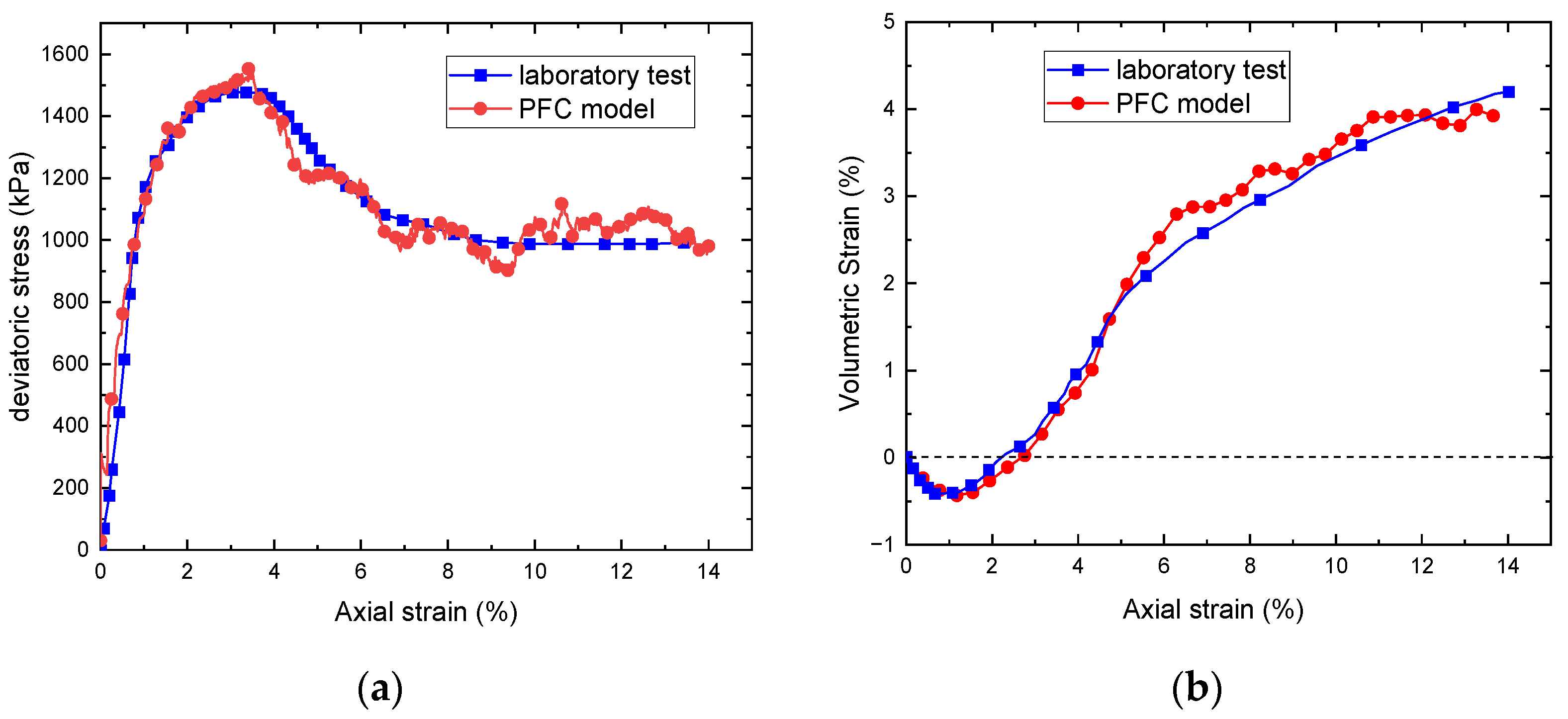
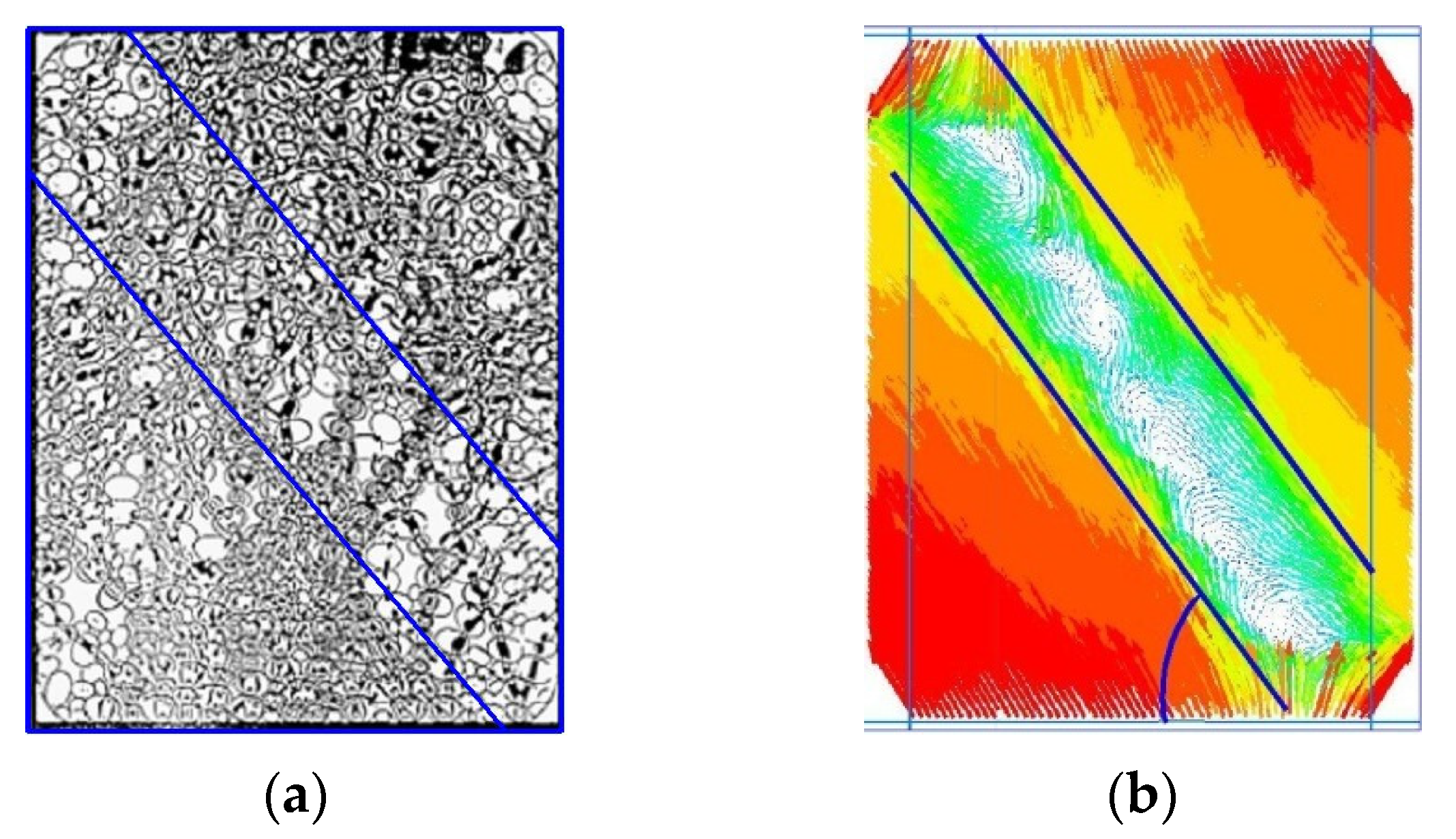


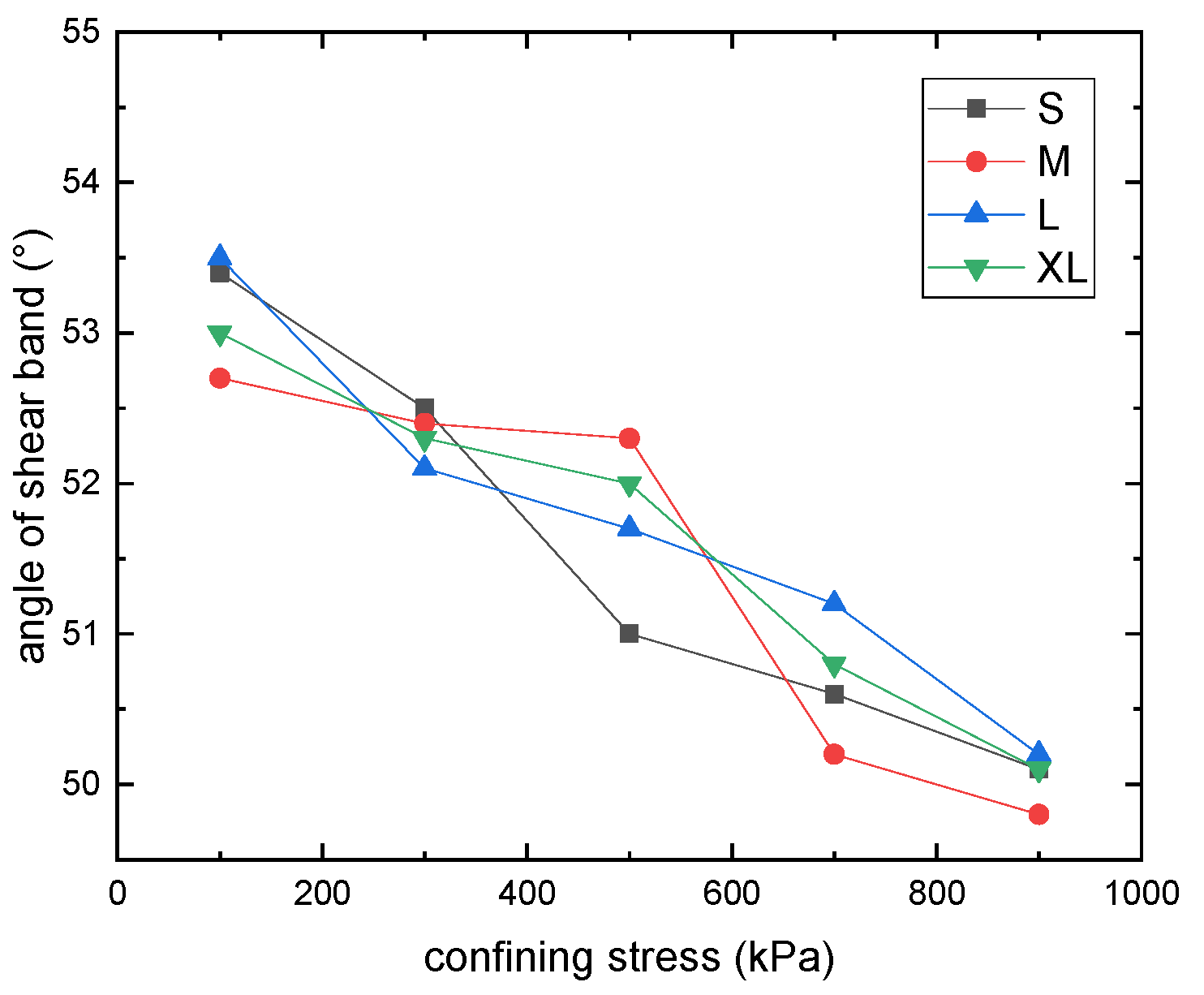
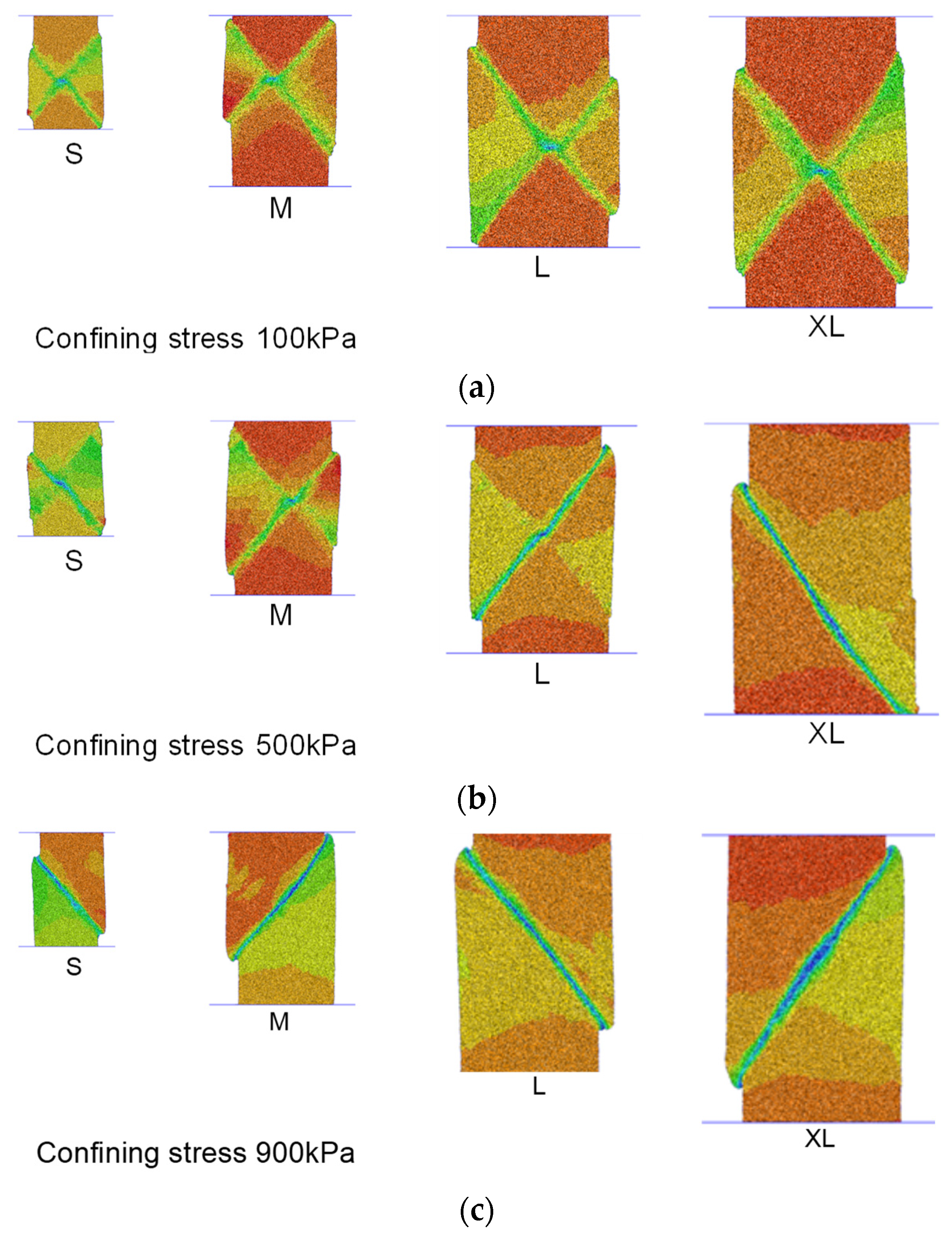
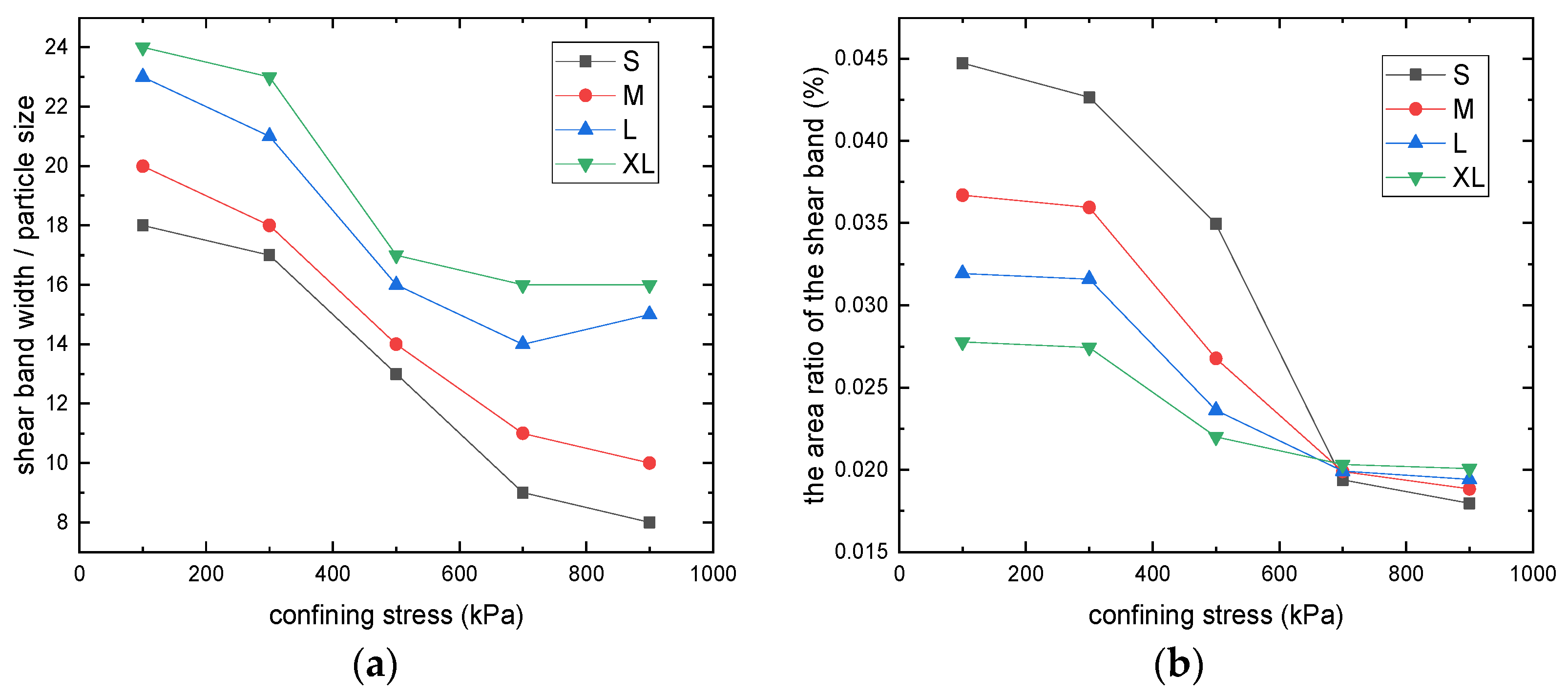
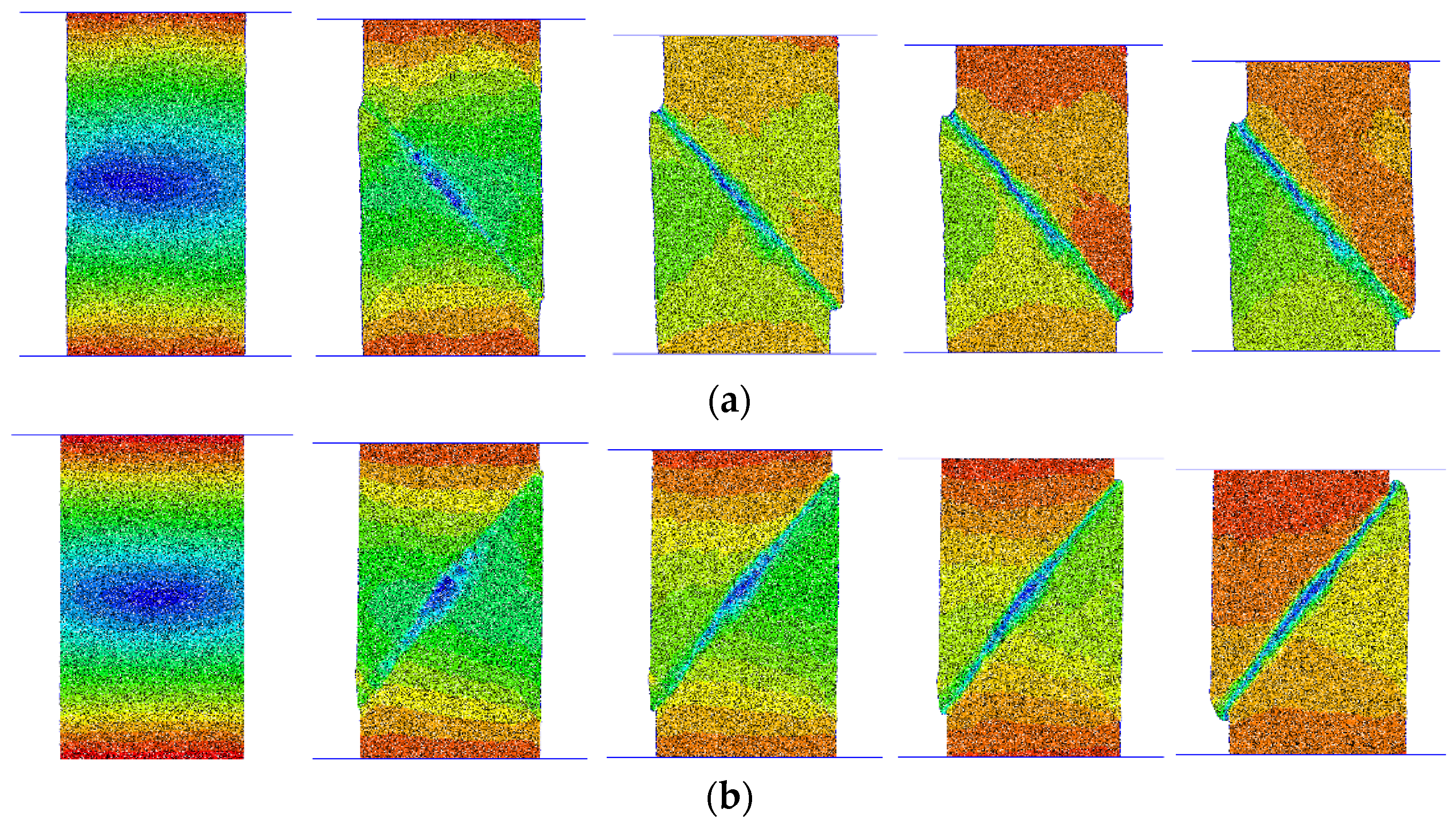
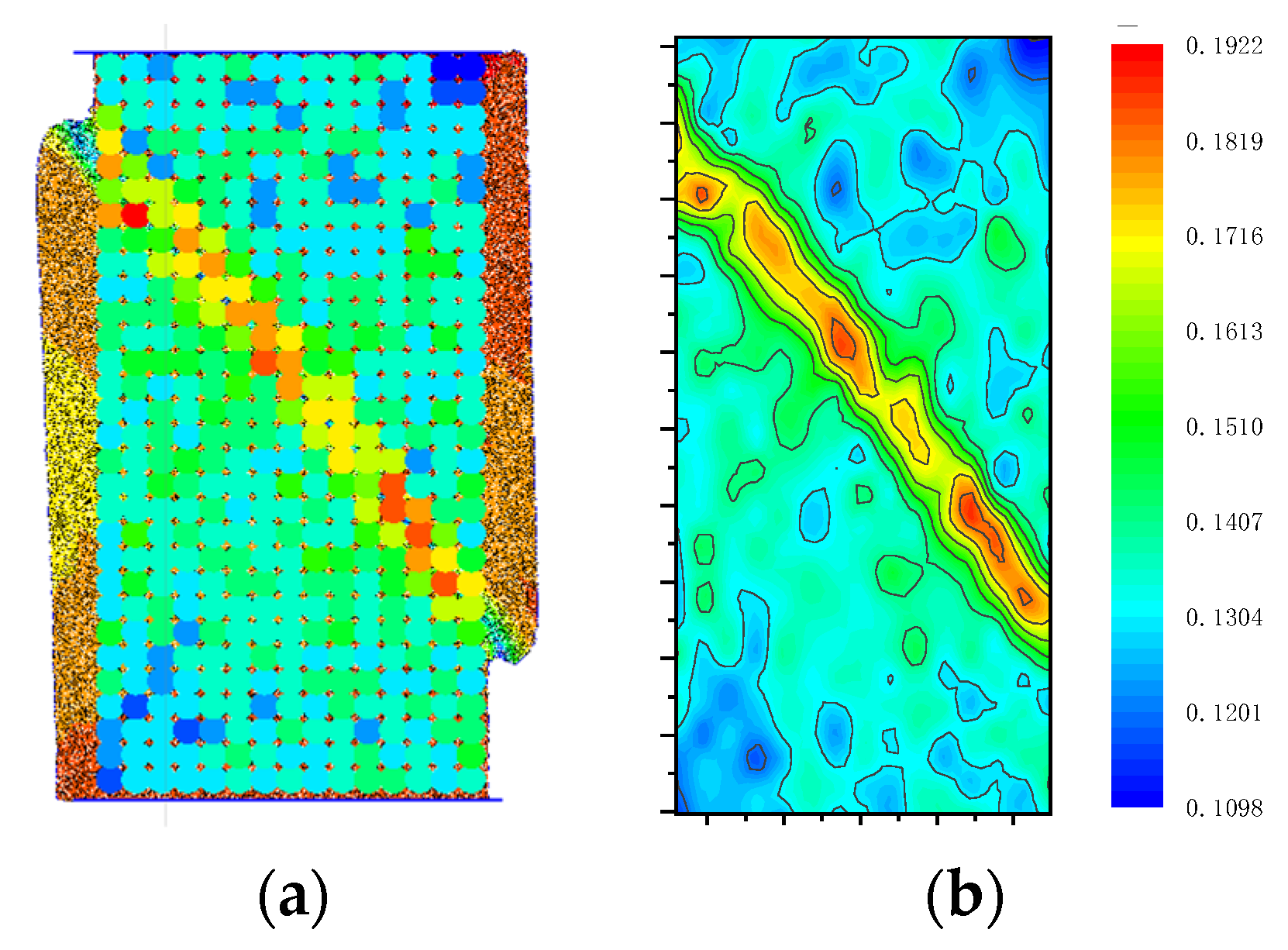
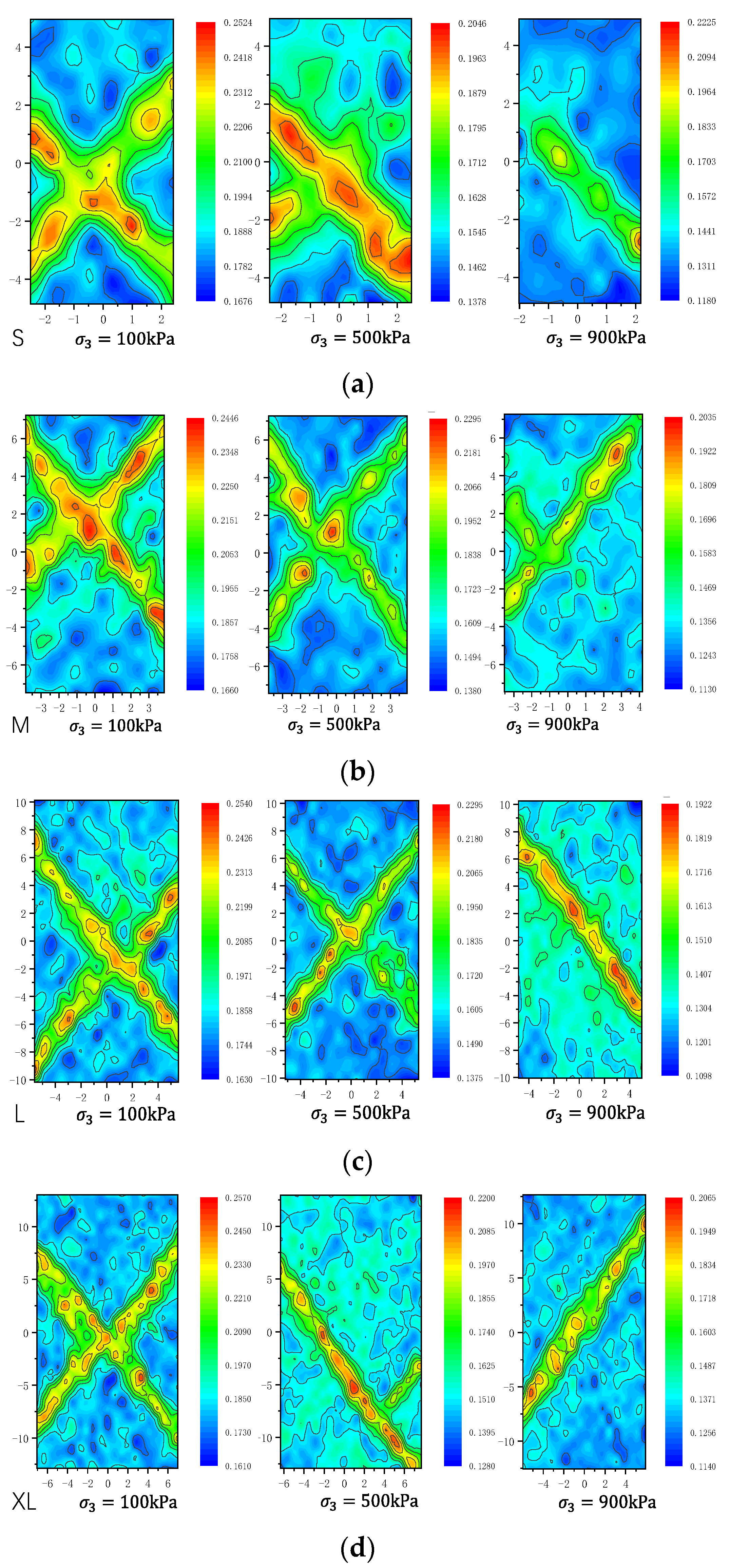

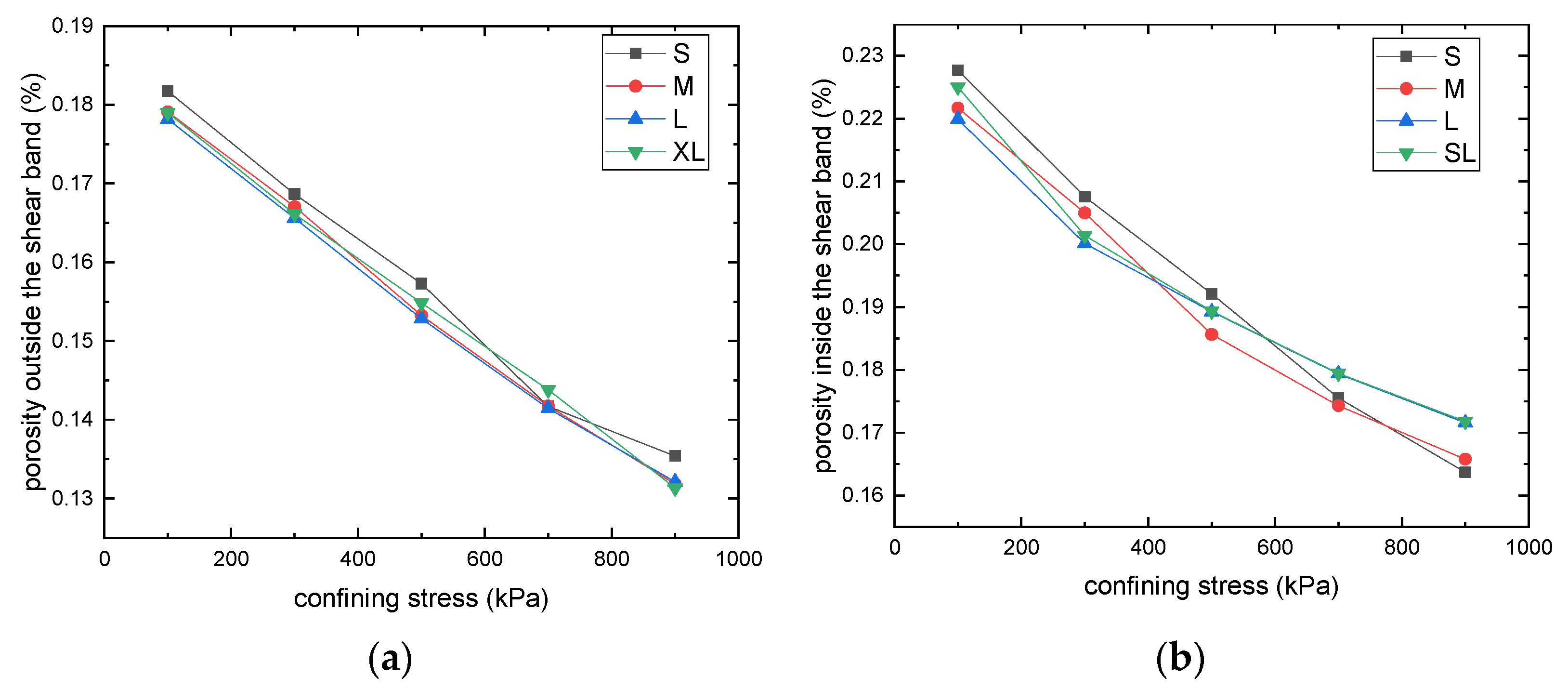
| Density (kg/m3) | Stiffness (N/m) | Bonding Strength (N/m) | Friction Coefficient | |||
|---|---|---|---|---|---|---|
| Normal | Tangential | Normal | Tangential | |||
| sand | 2600 | 1.0 × 108 | 0.5 × 108 | 0 | 0 | 0.4 |
| boundary | 1000 | 5.0 × 107 | 5.0 × 107 | 1 × 1030 | 1 × 1030 | 0.0 |
| Specimens | (mm) | (mm) | Particle Number | |
|---|---|---|---|---|
| S | 40 | 20 | 171 | 16,397 |
| M | 60 | 30 | 257 | 36,316 |
| L | 80 | 40 | 342 | 64,073 |
| XL | 100 | 50 | 482 | 99,577 |
Disclaimer/Publisher’s Note: The statements, opinions and data contained in all publications are solely those of the individual author(s) and contributor(s) and not of MDPI and/or the editor(s). MDPI and/or the editor(s) disclaim responsibility for any injury to people or property resulting from any ideas, methods, instructions or products referred to in the content. |
© 2024 by the authors. Licensee MDPI, Basel, Switzerland. This article is an open access article distributed under the terms and conditions of the Creative Commons Attribution (CC BY) license (https://creativecommons.org/licenses/by/4.0/).
Share and Cite
Mao, Z.; Zhang, L.; Zhang, N.; Chen, L. The Size Effect of Shear Bands in Dense Sands—A Discrete Element Analysis. Appl. Sci. 2024, 14, 4677. https://doi.org/10.3390/app14114677
Mao Z, Zhang L, Zhang N, Chen L. The Size Effect of Shear Bands in Dense Sands—A Discrete Element Analysis. Applied Sciences. 2024; 14(11):4677. https://doi.org/10.3390/app14114677
Chicago/Turabian StyleMao, Zongyuan, Luqian Zhang, Ning Zhang, and Lihong Chen. 2024. "The Size Effect of Shear Bands in Dense Sands—A Discrete Element Analysis" Applied Sciences 14, no. 11: 4677. https://doi.org/10.3390/app14114677
APA StyleMao, Z., Zhang, L., Zhang, N., & Chen, L. (2024). The Size Effect of Shear Bands in Dense Sands—A Discrete Element Analysis. Applied Sciences, 14(11), 4677. https://doi.org/10.3390/app14114677





